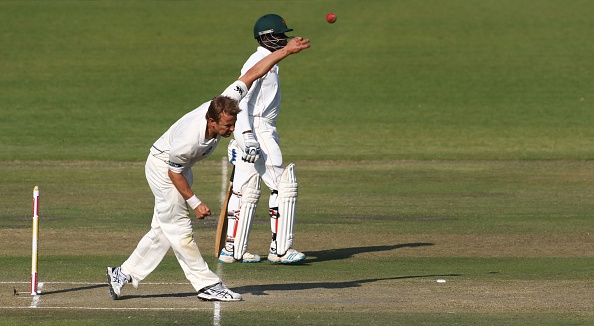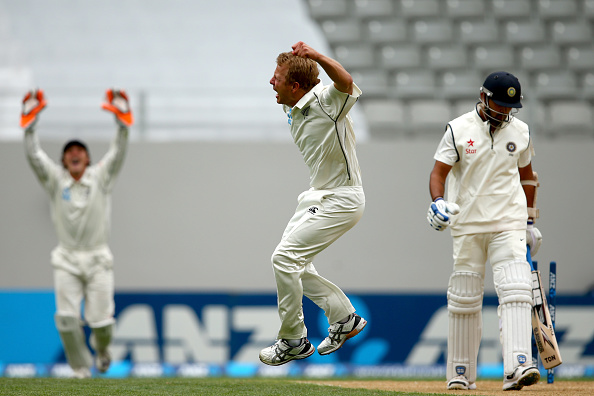
From South Africa’s substitute fielder to New Zealand’s bankable bowler in Tests - the journey of Neil Wagner

Meet Neil Wagner. New Zealand’s very own workhorse. The left-arm fast bowler has become an inevitable part of New Zealand’s bowling attack in Tests, quietly working in the shadows of the more celebrated bowlers, Trent Boult and Tim Southee.
According to him, five over spells are good but not good enough. A fast bowler tends to get worked up during long spells, losing shape and pace as the spell progresses. Not Wagner. He loves 10-over spells. He prides himself on being able to run in and bowl against the wind or tirelessly bounce batsmen out in long spells. He is a hard worker and a hell of a committed cricketer.
Early Life
Wagner was born and brought up in Pretoria, South Africa, where he attended Afrikaans High School. He played for the Northerns in 2005-06, earning his reputation as a wicket-taker with two four-wicket hauls in his first two games.
He was soon part of the national academy side that toured Zimbabwe and Bangladesh and despite finishing the Provincial Challenge series of 2006-07 as the leading wicket taker, Wagner was not deemed good enough for national selection.
The left-armer had stood in as a substitute fielder during Test matches in Centurion and had bowled in the South African nets several times. Former South African all-rounder, Shaun Pollock, vividly remembers Wagner as a swing bowler, who loved taking the new ball. But sadly for South Africa and Wagner, the partnership with his home country never blossomed.
With the ‘quota’ rule in the back of his mind, Wagner was forced to rethink his dreams and he switched allegiances, flying off to New Zealand, the second most favourable destination for players from the Rainbow Nation after England.
New Zealand doors open after world record feat
By June 2009, Wagner was part of the Kiwis’ Emerging Players team. But his moment of fame came in April 2011, when he picked up five wickets in a six-ball over, the only such instance in the history of First-class cricket. In the 70th over, Wagner got four wickets in four balls before taking one more in the last ball of the same over to complete a memorable feat.
A year later he was included in the Test side for the tour of the Caribbean Islands. The 30-year-old played two Tests and picked up four wickets in all, not quite impressing but not poor enough to drag him out of the selector’s radar.
He was back in the Test side for a tour of his home country, South Africa, where he played just one match, in Port Elizabeth. He bowled short and wide for the most part and the Protea batsmen whacked him to all corners of the park. He returned with figures of 1/135 but somehow managed to hold onto his spot for the home series against England.
The year 2013
Wagner started off 2013, his second year in international cricket, by feeding South African batsmen with loose balls which were punished. But his fortunes turned around quicker than he anticipated. He enjoyed a splendid home series against England, where he picked 12 wickets in 3 Tests, with a best of 4/42. He was a certainty for the return series in England but did not fare all that well with 7 scalps in 2 Tests.
In the tour of Bangladesh, Wagner picked up his maiden test fifer with a 5/64 on a typical sub-continental wicket. He showed his ability to run in and bowl quickly over after over.
He finished 2013 with 35 wickets in 10 matches, the most number of games he has played in a year thus far.
The home series against India in 2014
By 2014, Wagner was a regular in the Test side although he was the first to make way if New Zealand needed a different kind of bowler. With Trent Boult and Tim Southee established in the side, Wagner had a slightly boring job – that of containment. But Brendon McCullum had made the Black Caps a terrific Test side and he knew Wagner was an important player in the side.
Then came India’s tour to New Zealand. The first Test was at Auckland and the Kiwis had put up 503 on the board courtesy the skipper’s double hundred. Wagner took four in the first innings, including the key scalps of Dhawan and Dhoni as India were bowled out for 202. New Zealand, however, failed to drive home the advantage and crumbled to 105 all out, setting India 407 to win.
There is a thing about pitches in New Zealand. They get better for batting as the game progresses as opposed to pitches in the rest of the world, which deteriorate by the time day 4 arrives. This meant 407 wasn’t such a big target for a team like India, which boasted some prominent names in the batting line-up.

Dhawan and Kohli began putting on what was poised to be a match-winning partnership after Pujara was dismissed. Wagner, however, had other ideas as he was the best bowler on show for the Kiwis, with an impeccable opening spell of seven overs that went for just 18 runs. He almost dismissed the lynchpin, Kohli, before he was removed from the attack, but could not quite get the better of him as the now-India skipper and Dhawan began to build the innings.
The Kiwis were under pressure to get a breakthrough and McCullum went to Wagner again.
He turned the match on its head with a spell of 10 overs that yielded just 26 runs and produced the wickets of Kohli and Dhawan, the two set batsmen. More than the wickets, it was the manner in which Wagner got those scalps that stood out. He was persistent with his bouncers and had the Indian pair hopping around.
He wasn’t done, though. Dhoni and Zaheer took India within 60 runs of victory when McCullum called upon his best bowler in the Test yet again. Wagner promptly delivered by dismissing Zaheer in his first over and cleaning up Dhoni from around the wicket to finish with four in the second innings.
A captain’s dream
McCullum was all praise for Wagner after his superb display. "He epitomises everything we want to be known for as a team, how aggressive he is, how hostile he is when he has got ball in hand and how big his heart is as well," a proud skipper said.
"He bowled 10 overs into the wind late on day four which is no easy feat and it allowed Tim and Trent to have some decent downtime leading into that new ball. He never wants an opportunity to pass him by. His role is to bowl a lot of overs, and hostile overs. [He] gives Tim and Trent an opportunity to attack. He has thoroughly deserved his wickets. He has turned this game."
Wagner did turn the game and possibly his career too.
The change in roles
Wagner came to New Zealand as an out and out swing bowler. But now, he plays a support role, a difficult one, where he bowls against the wind or on a fifth stump line to frustrate the batsmen before putting in the odd bouncer. So what changed?
The realisation that he needed to offer something different to have a career in Test cricket.
Wagner understood that the Kiwis had good swing bowlers in Southee and Boult and unless he brought in something different to the table, he would be just another first-class bowler, who had odd days of joy and ecstasy. This realisation made him think about what he could do to get into the national setup.

Pitches in New Zealand being slower than in South Africa, Wagner realised that he needed to be the workhorse for the team. New Zealand had never had such a bowler, one of the Peter Siddle, Makhaya Ntini or Mohammad Shami kind, someone who could run in relentlessly all day and put pressure on the batsmen.
He learned how to bowl into the wind and hard into the wicket. He quickly became more aggressive, sneaking in a bouncer every now and then, making sure he added the extra effort each time he bowled a bumper.
I pride myself in when it is tough and if conditions are hard, I want to stand up and make the difference. It doesn't always happen, it is cricket, but on the day when it does come off, it feels great. Be as aggressive as I can be,” Wagner told ESPNCricinfo in 2014.
The difference from other bowlers
By being outright aggressive, Wagner has his bad days. While some days the bouncer ploy gets five wickets, like it did when he bounced out half the Australian line-up in a Test in Christchurch, on other days the ball sits up to be hit and he gets whacked.
He might not be a Test bowler that has a miserly economy of 2.5 and an average of 22. But what he does is take wickets by being consistently aggressive to the point where batsmen decide enough is enough and take him on, more often than not with poor results.
His skills are an aberration to what is expected from Test bowlers. He loves bowling on flat wickets and wickets that offer little to pace bowlers. For most of the seamers, such pitches are nightmares as it means a hard day on the field. But Wagner loves it. The tired legs and aching shoulders turn his performances on.

He is aware that on a Newlands or WACA wicket where the ball swings, his job is to clean up the leftovers from the party after Southee and Boult have had their share of the spoils. But on a Nagpur or Dhaka wicket, New Zealand need him in a different role altogether. That is what Wagner brings to the table. He isn’t scared of the pain of a long day on the field. He knows what he signed up for when he chose to become a fast bowler. The inspiration for that came from another legendary fast bowler, Allan Donald.
“I was told by Allan Donald as a young kid growing up that you are always going to have pain as a fast bowler, you are always going to have something that is sore, some sort of niggle. You are never going to play a 100% and feel a 100%. You know you have to bite through your teeth, and make sure you keep fighting.”
The usage of skills
He is aware that he can keep practising different skills in the nets but unless he employs them successfully in a Test match, they aren’t adding enough value. Wagner learned to use the crease wisely and brought it into play in that Test against India in 2014. He bowled Dhoni with a delivery from around the wicket, going wide off the crease and creating a different angle.
Yet again, in a Test against Lanka in 2015, Wagner dismissed a set Angelo Mathews after observing his tactic against short balls. Mathews was negotiating Wagner’s bouncers by going across the line and pushing them to the leg side. Wagner decided to go for a full ball on leg stump and cleaned up the Lankan skipper.
These are quiet moments in a Test match. Not a hat-trick or a stunning six over square leg. In batting terms, a crucial single by a set batsmen off the last ball of an over to keep strike when batting with a tail ender. It is a quiet moment, less appreciated but as valuable as a five-wicket haul.
That is exactly what Wagner does and prides himself on. He may make way for a spinner on a turning wicket or for a swing bowler on a green pitch, but ultimately he returns because pitches are flat these days and bowlers of his kind are a rarity.
2016
2016 was Wagner’s time to be in the limelight. The magic of Boult and the quirkiness of Southee could not always last and Wagner got his opportunity. He picked up 41 wickets in 2016 in 9 Test matches, finishing 10 wickets above New Zealand’s next best bowler, Boult, who played one match more than Wagner.

The Otago fast bowler had a best of 6/41 and an average of 21.04 with 3 five-wicket hauls. It was in contrast to his previous years at the highest level, where he mostly performed in the background. But the time had come to step up and he did it in his own special way. Even his strike rate, 46.8, was lower than that of the top wicket taker in the year, Ravichandran Ashwin.
What the future holds
There is no doubting his credentials anymore and the world now knows what Wagner can do. But these kinds of bowlers, unlike mystery bowlers of Sri Lanka, do not fade away once the opposition realizes what they can do. They only keep getting better as the years go by. They thrive on pressure and consistency.
With 28 Tests and 114 wickets under his belt, Wagner is an established figure now. He has played in all major cricketing continents and has excelled almost everywhere. He is the second fastest Kiwi bowler to 100 Test wickets, next to Richard Hadlee, taking just 25 Tests to reach the landmark. Boult and Southee took 29 Tests, on the other hand.
However, there is still a long way to go for this 30-year-old. He has a terrific List A record of 133 wickets in 88 games at a strike rate of 30.3, but he hasn’t made his ODI debut yet. It is strange considering the fact that New Zealand have had few quick bowlers to bank on in ODIs apart from Southee, McCleneghan, Boult and Matt Henry. Someone of Wagner’s stature, with proven Test credentials and a good List A record, needs to get a look in.
A debut is surely not far off and when it comes, Wagner will be ready.